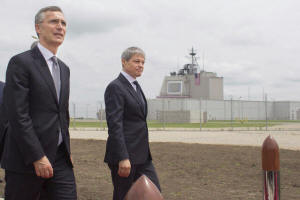|
U.S. activates Romanian missile defence
site, angering Russia
 Send a link to a friend
Send a link to a friend
[May 12, 2016]
By Robin Emmott
DEVESELU, Romania (Reuters) - The United
States switched on an $800 million missile shield in Romania on
Thursday, a step it sees as vital to defend itself and Europe from
so-called rogue states but which the Kremlin says is aimed at blunting
its own nuclear arsenal.
|

NATO Secretary General Jens Stoltenberg (L) and Romanian Prime Minister
Dacian Ciolos arrive for an official inauguration ceremony at Deveselu
air base, Romania, May 12, 2016. Inquam Photos/Octav Ganea/via REUTERS |
|
 To the music of military bands at the remote Deveselu air base,
senior U.S. and NATO officials declared operational the ballistic
missile defence site, which is capable of shooting down rockets from
countries such as Iran that Washington says could one day reach
major European cities. To the music of military bands at the remote Deveselu air base,
senior U.S. and NATO officials declared operational the ballistic
missile defence site, which is capable of shooting down rockets from
countries such as Iran that Washington says could one day reach
major European cities.
"As long as Iran continues to develop and deploy ballistic missiles,
the United States will work with its allies to defend NATO," said
U.S. Deputy Defence Secretary Robert Work, standing in front of the
shield's massive grey concrete housing that was adorned with a U.S.
flag.
Before the ceremony, Frank Rose, deputy U.S. assistant secretary of
state for arms control, warned that Iran's ballistic missiles can
hit parts of Europe, including Romania.
When complete, the defensive umbrella will stretch from Greenland to
the Azores. On Friday, the United States will break ground on a
final site in Poland due to be ready by late 2018, completing the
defence line first proposed almost a decade ago.
 The full shield also includes ships and radars across Europe. It
will be handed over to NATO in July, with command and control run
from a U.S. air base in Germany.
Russia is incensed at such of show of force by its Cold War rival in
formerly communist-ruled eastern Europe. Moscow says the U.S.-led
alliance is trying to encircle it close to the strategically
important Black Sea, home to a Russian naval fleet and where NATO is
also considering increasing patrols.
"It is part of the military and political containment of Russia,"
Andrey Kelin, a senior Russian Foreign Ministry official, said on
Thursday, the Interfax news agency reported.
"These decisions by NATO can only exacerbate an already difficult
situation," he added, saying the move would hinder efforts to repair
ties between Russia and the alliance.
"NO THREAT" TO RUSSIA
The readying of the shield also comes as NATO prepares a new
deterrent in Poland and the Baltics, following Russia's 2014
annexation of Crimea. In response, Russia is reinforcing its western
and southern flanks with three new divisions.
Poland is concerned Russia may retaliate further by announcing the
deployment of nuclear weapons to its enclave of Kaliningrad, located
between Poland and Lithuania. Russia has stationed anti-aircraft and
anti-ship missiles there, able to cover huge areas and complicate
NATO's ability to move around.
The Kremlin says the shield's aim is to neutralise Moscow's nuclear
arsenal long enough for the United States to strike Russia in the
event of war. Washington and NATO deny that.
[to top of second column] |

"Missile defence ... does not undermine or weaken Russia's strategic
nuclear deterrent," NATO Secretary-General Jens Stoltenberg said at
the Deveselu base.
However, Douglas Lute, the United States' envoy to NATO, said NATO
would press ahead with NATO's biggest modernisation since the Cold
War. "We are deploying at sea, on the ground and in the air across
the eastern flanks of the alliance ... to deter any aggressor," Lute
said.
At a cost of billions of dollars, the missile defence umbrella
relies on radars to detect a ballistic missile launch into space.
Sensors then measure the rocket's trajectory and destroy it in space
before it re-enters the earth's atmosphere. The interceptors can be
fired from ships or ground sites.
The Romanian shield, which is modelled on the United States'
so-called Aegis ships, was first assembled in New Jersey and then
transferred to the Deveselu base in containers.
While U.S. and NATO officials are adamant that the shield is
designed to counter threats from the Middle East and not Russia,
they remained vague on whether the radars and interceptors could be
reconfigured to defend against Russia in a conflict.
The United States says Russia has ballistic missiles, in breach of a
treaty that agreed the two powers must not develop and deploy
missiles with a range of 500 km (310.69 miles) to 5,500 km. The
United States declared Russia in non-compliance of the treaty in
July 2014.

The issue remains sensitive because the United States does not want
to give the impression it would be able to shoot down Russian
ballistic missiles that were carrying nuclear warheads, which is
what Russia fears.
(Additional reporting by Jack Stubbs and Andrew Osborn in Moscow;
Editing by Tom Heneghan)
[© 2016 Thomson Reuters. All rights
reserved.]
Copyright 2016 Reuters. All rights reserved. This material may not be published,
broadcast, rewritten or redistributed. |